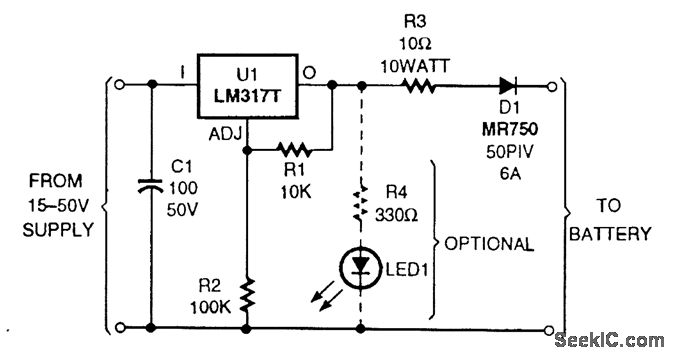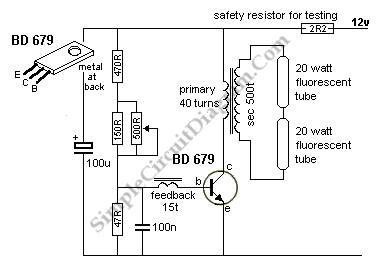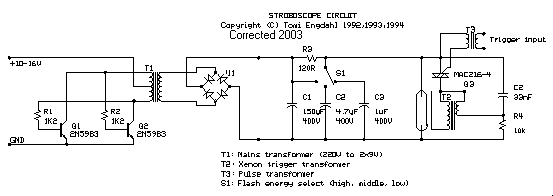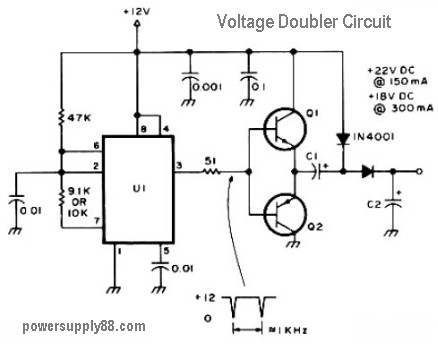
CW117 CW217 CW317 12V constant-voltage charger

A 12V constant voltage charger is depicted. The power supply circuit shares the same basic design. The resistor R1, valued at 0.2 ohms, serves a limiting function, effectively increasing the internal resistance of the charger, which in turn reduces the charging rate. In the initial stage, the integrated voltage regulator functions as an overcurrent protection mechanism.
The 12V constant voltage charger circuit operates on the principle of maintaining a steady output voltage of 12 volts, regardless of variations in load or input voltage. The circuit typically consists of a transformer, rectifier, filter, and voltage regulator. The transformer steps down the AC voltage to a suitable level, while the rectifier converts the AC voltage to DC.
A smoothing capacitor follows the rectifier to filter out voltage ripples, providing a more stable DC output. The role of resistor R1, valued at 0.2 ohms, is crucial in limiting the charging current to prevent excessive current flow that could damage the battery or the charger itself. By increasing the internal resistance of the charger, R1 effectively slows down the charging process during the initial phase, allowing for a safer and more controlled charging environment.
The integrated voltage regulator plays a dual role in this circuit. Primarily, it ensures that the output voltage remains at a constant 12 volts, even when the input voltage fluctuates or when the load changes. Additionally, it provides overcurrent protection, which is essential for safeguarding both the charger and the connected battery. If the current exceeds a predetermined threshold, the voltage regulator will adjust its output to prevent damage, thereby enhancing the reliability and longevity of the charger.
Overall, this circuit design is essential for applications requiring a stable and reliable charging solution, such as in battery charging systems for various electronic devices. Proper selection of components, including the transformer, rectifier, and voltage regulator, along with careful consideration of resistor values, is critical for achieving optimal performance and safety in the charging process. As shown is a 12V constant voltage charger. The power supply circuit with the same basic circuit. Resistance Rl 0.2, limiting the role played, the equivalent of increasing the internal resistance of the charger can reduce the charging rate of charging the initial stage of the integrated voltage regulator plays the role of overcurrent protection.
The 12V constant voltage charger circuit operates on the principle of maintaining a steady output voltage of 12 volts, regardless of variations in load or input voltage. The circuit typically consists of a transformer, rectifier, filter, and voltage regulator. The transformer steps down the AC voltage to a suitable level, while the rectifier converts the AC voltage to DC.
A smoothing capacitor follows the rectifier to filter out voltage ripples, providing a more stable DC output. The role of resistor R1, valued at 0.2 ohms, is crucial in limiting the charging current to prevent excessive current flow that could damage the battery or the charger itself. By increasing the internal resistance of the charger, R1 effectively slows down the charging process during the initial phase, allowing for a safer and more controlled charging environment.
The integrated voltage regulator plays a dual role in this circuit. Primarily, it ensures that the output voltage remains at a constant 12 volts, even when the input voltage fluctuates or when the load changes. Additionally, it provides overcurrent protection, which is essential for safeguarding both the charger and the connected battery. If the current exceeds a predetermined threshold, the voltage regulator will adjust its output to prevent damage, thereby enhancing the reliability and longevity of the charger.
Overall, this circuit design is essential for applications requiring a stable and reliable charging solution, such as in battery charging systems for various electronic devices. Proper selection of components, including the transformer, rectifier, and voltage regulator, along with careful consideration of resistor values, is critical for achieving optimal performance and safety in the charging process. As shown is a 12V constant voltage charger. The power supply circuit with the same basic circuit. Resistance Rl 0.2, limiting the role played, the equivalent of increasing the internal resistance of the charger can reduce the charging rate of charging the initial stage of the integrated voltage regulator plays the role of overcurrent protection.





